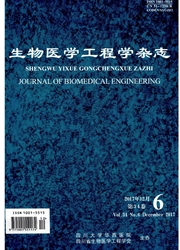

 中文摘要:
中文摘要:
近年来,电阻抗断层成像(EIT)和磁共振电阻抗成像(MREIT)等基于人体组织电特性(EPs)的成像方法已经成为生物医学界的研究热点。与EIT和MREIT相比,基于射频场成像的电特性成像(MR—EPT)是一种新近提出的无损EPs成像方法,该技术基于磁共振(MRI)射频场对生物组织电导率和介电常数进行重建,无需注入电流即可获得高分辨率和高精度的图像。本文对几种基于EPs的成像方法及其发展现状进行了详细阐述,并着重对MR—EPT的原理、优点、发展前景及通过它来测量比吸收率(SAR)的方法进行介绍。总之,MR-EPT值得受到更广泛地关注,并有待进行更深入的研究,以促进医学检测水平再创新突破。
 英文摘要:
英文摘要:
In recent years, the technologies based on the electrical properties (EPs) of human tissue, such as electri- cal impedance tomography (EIT) and magnetic resonance electrical impedance tomography (MREIT), have become one of the most popular research subjects in biomedicine. Compared with EIT and MREIT, the magnetic resonance electrical property tomography (MR-EPT) is a new technique using nondestructive EPs method. MR-EPT recon- structs the electrical conductivity and permittivity of the biological tissues based on the radio frequency field of the magnetic resonance imaging (MR/) system. It can obtain an accurate and high resolution image without current injection. In this paper, several methods for the EPs are reviewed, especially the MR-EPT. The theory, advantages and prospects of MR-EPT's are elaborated. The method of specific absorption rate (SAR) based on it is also introduced. MR-EPT is deserved further research and should be given more attention by the researchers. All this evolution based on MREPT can give new energy to the medical diagnosis.
 同期刊论文项目
同期刊论文项目
 同项目期刊论文
同项目期刊论文
 期刊信息
期刊信息
